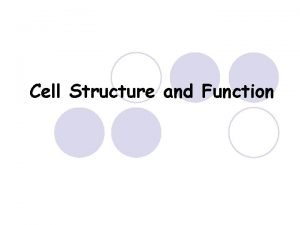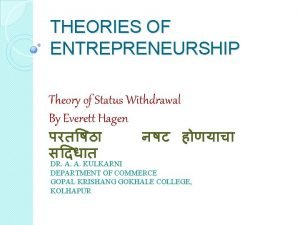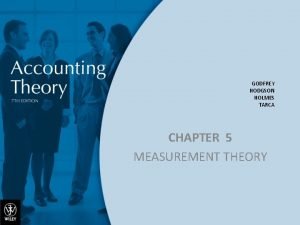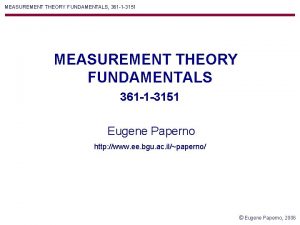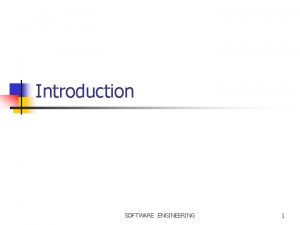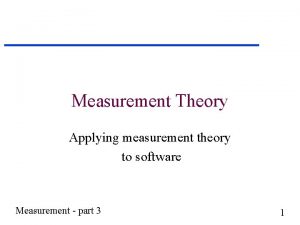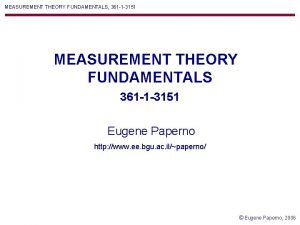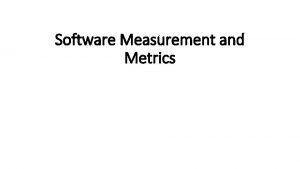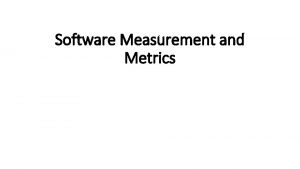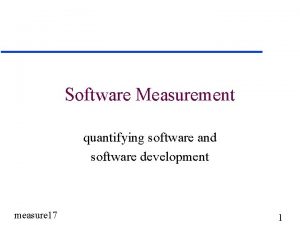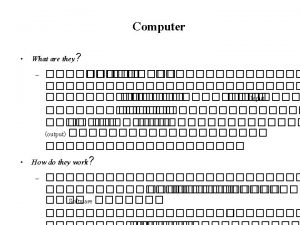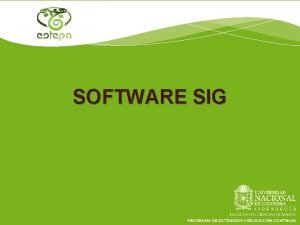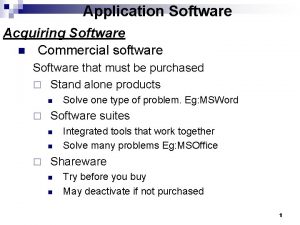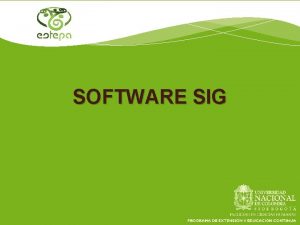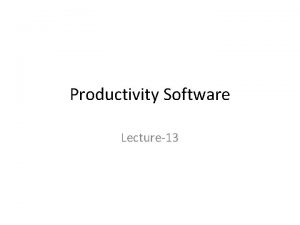Software Measurement Theory Measurement part 2 1 Measurement





















- Slides: 21

Software Measurement Theory Measurement - part 2 1

Measurement Theory u circa 1900 - applied to physics u 1940’s - applied to psychology, sociology u 1990’s - applied to software measurement Measurement - part 2 2

Representational TOM u empirical relation system – (C, R) u numerical relation system – (N, P) u. M maps (C, R) to (N, P) u representation condition – x<y => M(x)<M(y) Measurement - part 2 3

Empirical u. A set of entities, E u A set of relationships, R – often “less than” or “less than or equal” – note that not everything has to be related Measurement - part 2 4

Numerical u A set of entities – also called the “answer set” – usually numbers - natural numbers, integers or reals u. A set of relations – usually already exists – often “less than” or “less than or equal” Measurement - part 2 5

The Mapping u The representation condition – M(x) rel M(y) if x rel y – x rel y iff M(x) rel M(y) u Both have been used by classical measurement theory authors u I prefer the first definition Measurement - part 2 6

“BIG” example u We want to measure people as BIG – i. e. height and weight u Empirically, if two people are the same height, the heavier is bigger – if two people are the same weight, the taller is bigger u Answer set is real or tuple? Measurement - part 2 7

Classic Example u Mc. Cabe’s Cyclomatic Number u Empirical - Control Flow Graph u Numerical (Answer Set) - integers u mapping - E-N+2 Measurement - part 2 8

Empirical u How can we rank Mc. Cabe’s? u What is the relationship? u What is a partial order? Measurement - part 2 9

Creating a New Theory Why should a theory devised for physical phenomenon be useful for software - an artificial phenomenon? Measurement - part 2 10

Empirical Relations u One cludge that appears very often in the computer science literature is to define the empirical relation as that which makes the representation condition hold for the measure u The truth is that we do not have centuries of consensus on the empirical relationships Measurement - part 2 11

Artificial u Software has been described as an artificial science because we control the objects. In fact, the objects are artifacts - made by humans u However, if there are constraints on these artifacts, it is usually in the operations that can change the artifacts Measurement - part 2 12

Transformations u Consider the transformations that you can do to a syntactically correct program that maintains the correctness: – – – add a statement add a condition remove a statement Measurement - part 2 13

MOM u Model - Order - Mapping u the model is the abstraction u the order is an ordering on the abstraction – can be partial, can be constructive u the mapping is from the model to the answer set – must preserve the order (I. e. rep condition) Measurement - part 2 14

MOM Measurement - part 2 15

Triangle Problem cin>>a>>b>>c; type=“scalene”; if (a==b||b==c||a==c) type=“isosceles”; if (a==b&&b==c) type=“equilateral”; if (a>=b+c||b>=a+c||c>=a+b) type=“not a triangle”; if (a<=0||b<=0||c<=0) type=“bad inputs”; cout<<type; Measurement - part 2 16

Triangle CFG 1, 2, 3 a 3 b 4 a 4 b 5 a 5 b 6 a 6 b 7 Measurement - part 2 17

Formal Spec u CFG is described by set of nodes {1, 3 b, 4 a, 4 b, 5 a, 5 b, 6 a, 6 b, 7} and set of arcs {(1, 3 b), (1, 4 a), (3 b, 4 a), (4 a, 4 b), (4 a, 5 a), (4 b, 5 a), (5 a, 5 b), (5 a, 6 a), (5 b, 6 a), (6 a, 6 b), (6 a, 7), (6 b, 7) Measurement - part 2 18

Partial Order u Originally, for all cfg x, y, x <=y if and only if all nodes and edges in x are also in y. u Thus adding an edge to x made a new cfg y such that x <= y but y may not be a cfg for a valid program u Constructive definition - x <= y if there is a set of transforms (additive) such that the transforms are applied to x produce y Measurement - part 2 19

Representation Condition u Can prove that for all cfg’s x and y, if x<=y then m(x) <= m(y) u Note that this is not the iff rep condition. Since the partial orders on the abstractions are partial, if can only be one way Measurement - part 2 20

Proof of monotonicity u Can show that no additive transform can decrease the cfg or the value of the mapping u Can show that additive transforms of adding if-then, if-then-else, while will always result in an increase of 1 in the value of the mapping Measurement - part 2 21
 What is software measurement
What is software measurement Part whole model subtraction
Part whole model subtraction Unit ratio definition
Unit ratio definition Part part whole
Part part whole Technical description meaning
Technical description meaning The front bar
The front bar The part of a shadow surrounding the darkest part
The part of a shadow surrounding the darkest part Part to part variation
Part to part variation Product disassembly
Product disassembly Centrioles function
Centrioles function Theory of status withdrawal related to
Theory of status withdrawal related to Chapter 5 measurement theory godfrey
Chapter 5 measurement theory godfrey Basic measurement theory
Basic measurement theory Software maintenance process models ppt
Software maintenance process models ppt Frank maurer
Frank maurer How to improve software economics
How to improve software economics Computer science vs software engineering
Computer science vs software engineering What is software metrics in software engineering
What is software metrics in software engineering Chapter 3 skills and applications
Chapter 3 skills and applications Generic software vs custom software
Generic software vs custom software Difference between student software and industrial software
Difference between student software and industrial software Software crisis in software engineering
Software crisis in software engineering









